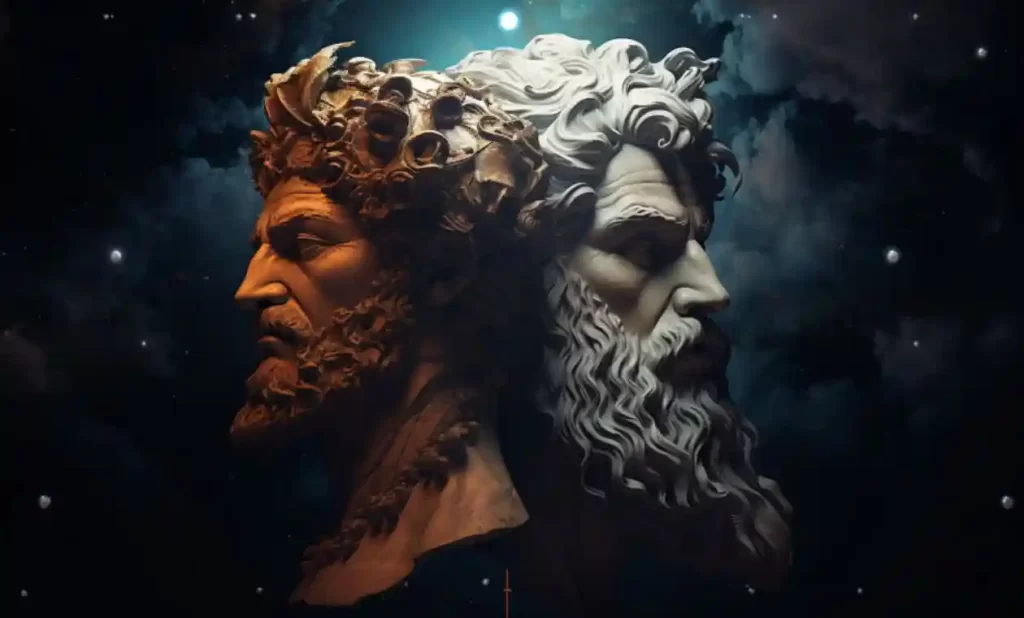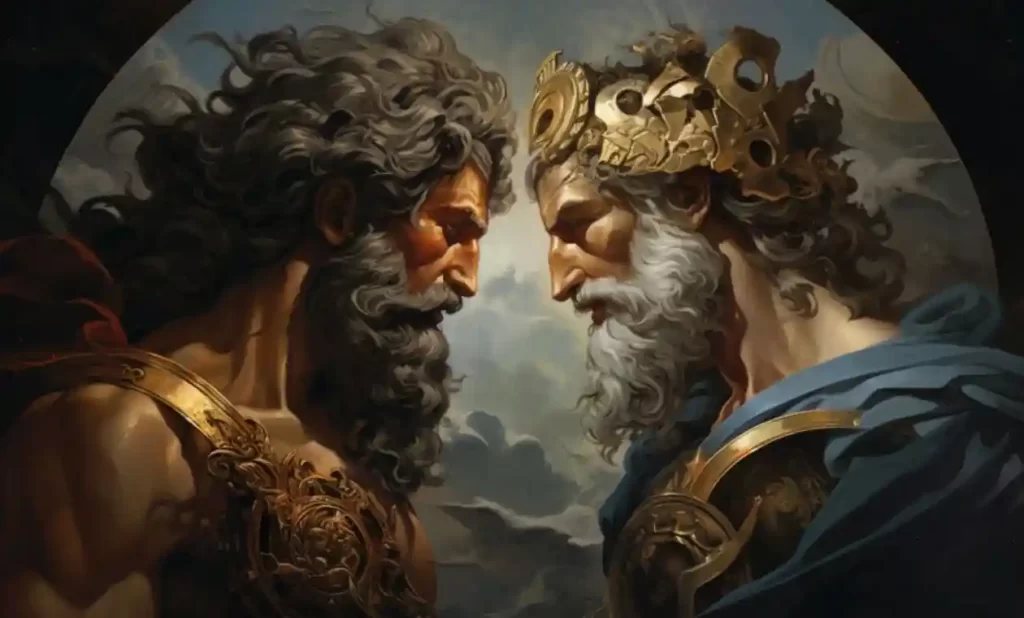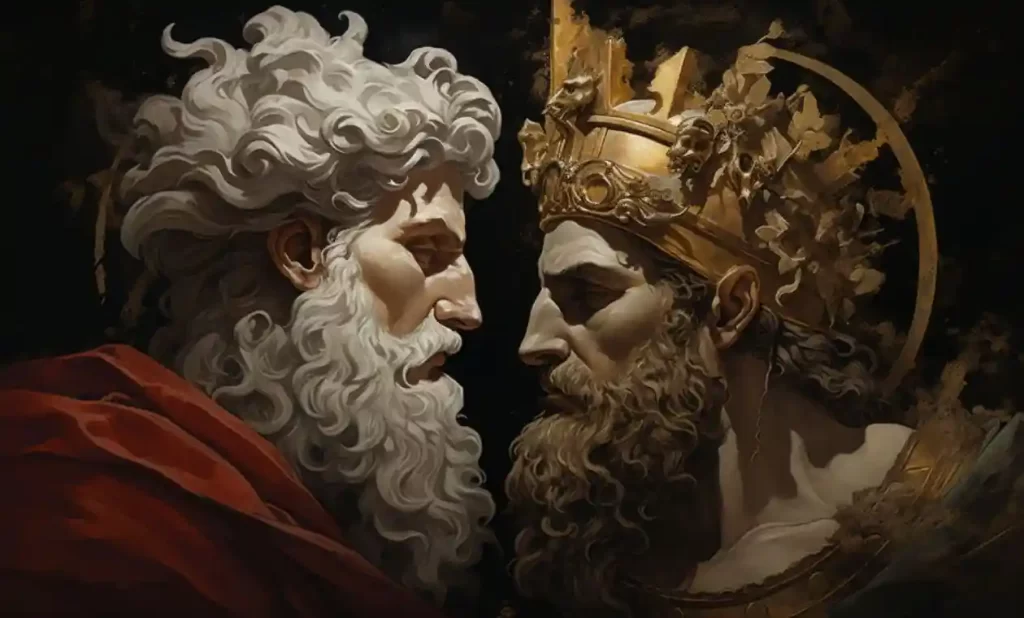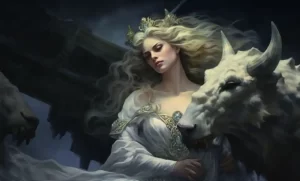
In the realm of Roman mythology, where gods and legends intertwine, one figure stands out as a fascinating embodiment of change and transformation. Meet Janus, a deity whose role extends beyond mere divinity, encompassing the very essence of beginnings, endings, and the passages that connect them. As we embark on this journey through Roman lore, let us delve into the captivating world of Janus, the god of transitions and doors.
In the grand tapestry of Roman deities, Janus assumes a distinctive place, one that resonates with the intricate nature of change. Amidst a pantheon of gods, each governing aspects of life, Janus emerges as the guardian of thresholds, watching over the moments when the old gives way to the new. But what sets Janus apart from his divine peers is his portrayal—forever captured with two faces gazing in opposite directions. This duality encapsulates his unique dominion over both past and future, marking him as a deity of profound significance.
Who is Janus? The Divine Custodian of Transitions
In the celestial realm of Roman mythology, Janus reigns as a prominent and captivating figure, often revered for his unique dominion over the delicate balance between old and new. A revered deity among the Roman pantheon, Janus stands as the embodiment of transitions, serving as the divine link between the past and the future. With his watchful gaze fixed upon the thresholds that mark significant passages in life, Janus’ presence is felt in the opening and closing of doors that shape destinies.
At the core of Janus’ essence lies his multifaceted role as the god of beginnings, endings, and doorways. In the symphony of existence, Janus holds the conductor’s baton, guiding the rhythmic flow of time as it ebbs and flows through moments of transformation. It is through his benevolent guidance that the commencement of new chapters and the conclusion of old ones find their harmonious rhythm.
However, what truly distinguishes Janus from other deities is the captivating duality encapsulated within his visage. With two faces, each looking in opposite directions, Janus is an embodiment of contrasts and connections. One face gazes fondly at the past, while the other gazes earnestly toward the future, simultaneously embodying the end and the beginning. This dual nature captures the essence of Janus’ realm—the continuous cycle of change, where the closing of one door marks the opening of another.
The Symbolism of Janus
As we journey further into the enigmatic realm of Janus, it becomes clear that his influence extends beyond the realms of mere representation, delving into the very symbols that define his essence. Among these symbols, the keys and gates emerge as emblems of Janus’ power to unlock the mysteries of transitions and open gateways between the stages of life.
The keys held by Janus are more than just ornate artifacts; they are metaphors for unlocking the doors that lead us from one phase to another. These keys, bestowed upon him by the gods, are reminders of his role as the guardian of pathways. Through his watchful presence, Janus holds the master key to the threshold of change, allowing us to traverse from the familiar to the unknown with grace and guidance.
Janus’ portrayal with doors, an iconic image in Roman artistry, is a living testament to his significance. Imagine standing before a closed door, the passage to new experiences and unexplored territories. In that moment, Janus’ duality comes to life, as his two faces reflect the dual nature of transition itself. The act of opening a door becomes a ritual, a rite of passage guided by Janus, ensuring that we step into the future while acknowledging the lessons of the past.
At the core of Janus’ symbolism is his role as a sentinel of thresholds—a guardian who stands unwaveringly between the old and the new. Just as he watches over the physical doorways that punctuate our lives, he also guards the intangible threshold of change, reminding us that every ending is a new beginning. The very act of passing through a gate, whether literal or metaphorical, is a homage to Janus, a recognition of the cyclical nature of existence that he embodies.
The Two-Faced God: Embracing the Past and Future

Among the divine tapestry of Roman mythology, Janus stands as an extraordinary figure, distinguished not only by his role but also by his captivating duality—the two faces that define his essence. These faces, gazing in opposite directions, hold the key to unlocking the depths of Janus’ significance as the god of beginnings, endings, and the bridges that link them.
Janus’ unique appearance is a testament to his dominion over time’s two eternal streams—the past and the future. With one face cast in contemplative reflection upon history and the other turned with eager anticipation toward the unknown, Janus stands as a bridge that unites the moments that have been and those yet to come. This visual dichotomy encapsulates the essence of change itself, reminding us that every beginning is born from an ending and that every ending paves the way for a new start.
In this duality, Janus becomes the living embodiment of the cyclical nature of existence—a deity who transcends the confines of linear time. Through his two faces, he weaves together the threads of moments long gone and moments not yet realized. With a gaze that spans both directions, he guards the threshold between what was and what will be, underscoring his role as the overseer of life’s pivotal junctures.
The two faces of Janus are more than just an artistic representation; they signify his power to exist in two realms simultaneously. He is the guardian of transitions, ensuring that the ties between past and future remain unbroken. Like a wise mentor, Janus teaches us that embracing change requires acknowledging the lessons of the past while embracing the possibilities that lie ahead. His dual nature serves as a gentle reminder that to embark on new beginnings, we must first honor the endings that paved the way.
Worship and Temples: Honoring the Guardian of Thresholds
In the heart of ancient Rome, Janus’ influence extended far beyond mere mythology, permeating the very fabric of daily life. The worship of this revered deity was a testament to his significance as the guide through life’s most crucial transitions, from birth to death and every moment in between.
In the bustling streets of Rome, Janus’ presence was felt through a spectrum of rituals and ceremonies, each paying homage to his role as the guardian of beginnings and endings. During pivotal life events such as marriages, births, and even the commencement of journeys, offerings were made to Janus to seek his benevolent guidance. This act of acknowledgment highlighted the belief that Janus’ watchful gaze blessed these milestones with a smooth transition, ensuring that every new chapter was ushered in with grace.
Janus’ veneration was further encapsulated in the grandeur of his temple, a structure that stood as a testament to his revered status. The design of his temple was a marvel in itself—a symbol of the deity’s dual nature. This temple, known as the “Janus Geminus,” featured doors on both ends, aligning seamlessly with Janus’ role as the custodian of gates and passages. Intriguingly, these doors held a unique significance in times of war and peace. When Rome was at war, the doors of the temple would remain open, symbolizing the city’s readiness to face challenges. In contrast, during times of peace, the doors would remain closed, signifying a state of internal harmony.
The Janus temple’s design was a living testament to the deity’s dual identity—a guardian who not only guided individual transitions but also stood as a sentinel over the fate of Rome itself. This dual symbolism underscored the interconnectedness between the personal and the collective, as Janus’ influence extended from the smallest thresholds to the grandest scale of societal change.
Myths and Stories: Janus’ Hand in Creation and History

Amidst the annals of Roman mythology, Janus’ presence is not confined to symbolism alone; it finds life in captivating tales that weave through the fabric of the universe and shape the course of history. Let us journey through two such stories—one that paints Janus as a participant in creation and another that highlights his influence during pivotal moments in Rome’s history.
The Tale of Creation: In the ancient myth of creation, Janus takes center stage, embodying the profound duality that exists within the universe itself. As the story goes, when the world was in its infancy, the god Saturn ruled over a golden era of peace. Seeking to create balance, Janus was brought forth, his two faces representing the past and the future. In this way, he bridged the gap between Saturn’s peaceful reign and the era of Jupiter, the ruler of gods, who brought forth the dynamism of change. Janus, with his dual gaze, played a crucial role in establishing the harmony between these contrasting forces, ushering in an age where past and future harmoniously coexist.
Janus in Roman History: In the annals of Roman history, Janus’ influence transcended myth and entered reality, playing a role in shaping the destiny of the Roman Empire itself. During moments of transition and change, Janus’ presence was invoked to bless these significant shifts. One such instance was the closing of the Janus temple’s doors. It is said that the doors were closed only three times in recorded history—during times of peace, signifying the harmony and stability that the empire enjoyed. However, these moments of peace were fleeting, and the doors remained open during times of conflict and war, symbolizing the readiness to face challenges head-on. This dynamic relationship with Janus captured the ebb and flow of Rome’s destiny, reflecting the cyclical nature of history and change.
Janus and Time
Janus’ presence in Roman mythology goes beyond mere symbolism; it delves into the very essence of time itself. As we journey through this section, we’ll uncover the profound connection between Janus and the concept of time, revealing how his role as a guardian of thresholds shapes our perceptions of transitions and the unending dance of change.
Janus’ dual faces mirror the duality of time, an ever-flowing river that carries us from the past into the future. His gaze, fixed in two directions, encapsulates the unbreakable link between moments that have been and those that are yet to come. Just as doorways mark the points of transition in our lives, Janus stands as a guardian over the transitions of time itself—a sentinel who ensures that the threads of the past remain woven into the fabric of the future.
Janus’ influence on Roman perceptions of time is palpable, for his name has become synonymous with the very concept of beginnings and endings. Romans saw in Janus a reflection of their own experiences—a deity who embraced change and transition as an inevitable part of existence. By acknowledging Janus’ dominion, Romans embraced the idea that change was not to be feared, but rather welcomed as a natural part of life’s journey.
The Janus temple’s dual doors serve as an architectural metaphor for the passage of time. The act of opening and closing these doors during different times of peace and conflict parallels the cyclic nature of history itself. Janus’ presence in these rituals solidified the understanding that change was not linear but cyclical, a reminder that every ending was a prelude to a new beginning.
Janus in Modern Culture
The influence of Janus, the ancient god of beginnings and endings, reverberates through the corridors of time, leaving traces of his duality in modern culture. In this section, we’ll unveil the threads that connect Janus to the contemporary world and explore how his symbolism continues to resonate across fields like psychology and philosophy.
Modern references to Janus’ duality can be found in literature, art, and even the fabric of our language. The concept of looking both backward and forward finds a home in narratives that explore the interplay of past and future. Metaphorical doors that represent life’s transitions frequently open to reveal Janus’ dual gaze—a testament to the timelessness of his symbolism.
Janus’ duality remains relevant in psychology, where it mirrors the complexity of human thought and emotions. The interplay between retrospection and anticipation is a constant struggle in the human psyche. Just as Janus’ dual faces navigate the realms of time, individuals often grapple with reconciling their past with their aspirations for the future. In this way, Janus’ symbolism offers insight into the intricate workings of the human mind.
In philosophy, Janus’ presence is evident in discussions surrounding change, growth, and the cyclical nature of existence. His two faces serve as a metaphor for the dualities inherent in life—light and darkness, joy and sorrow, creation and destruction. Janus’ role as a guardian of transitions aligns with philosophical musings on the thresholds between different states of being, inspiring reflections on the interconnectedness of all things.
The digital age has embraced Janus’ symbolism in technology, as well. Modern tools of communication and social media platforms are, in a sense, doors that connect people across time and space, mirroring Janus’ role as a facilitator of connections and transitions.
Conclusion
As we draw the curtain on our journey through the realms of Roman mythology and the captivating tale of Janus, we find ourselves standing at the crossroads of past and present. In the intricate tapestry of gods and legends, Janus emerges as a deity of profound significance—a sentinel who guards the thresholds of life’s transitions, ushering in beginnings and bidding adieu to endings.
Janus’ essence lies not merely in the stories and symbols, but in the very fabric of our human experience. With each transition we face, every doorway we cross, his dual visage serves as a timeless reminder of the interplay between past and future. Just as his two faces gaze upon different horizons, so do we navigate the terrain of our lives—reflecting on the journey we’ve traveled while eagerly embracing the possibilities that lie ahead.
In Roman mythology, Janus is the guide who ushers us through the ever-shifting landscapes of existence. His keys unlock the doors to new chapters, his doors mark the turning points of time, and his dual faces mirror the dualities we encounter within ourselves. Janus’ presence transcends ancient times; it echoes in the corridors of our modern world, resonating in fields as diverse as psychology, philosophy, and technology.
Hey kids, how much did you like Janus: Roman God of Beginnings & Endings? Please share your view in the comment box. Also, please share this story with your friends on social media so they can also enjoy it, and for more such Roman Mythology, please bookmark storiespub.com.
Related Article –





